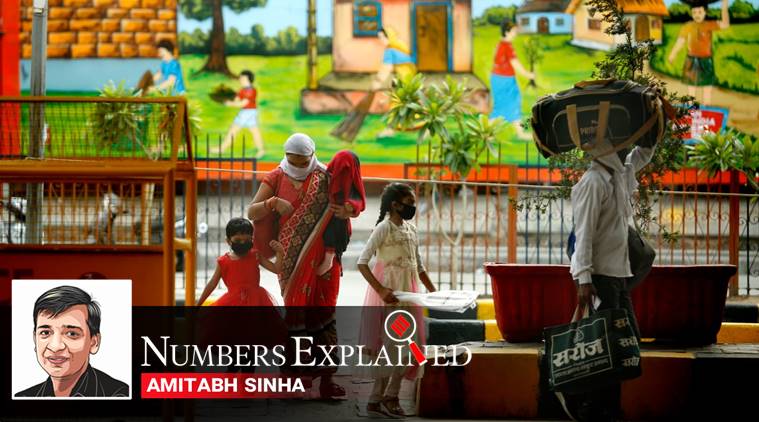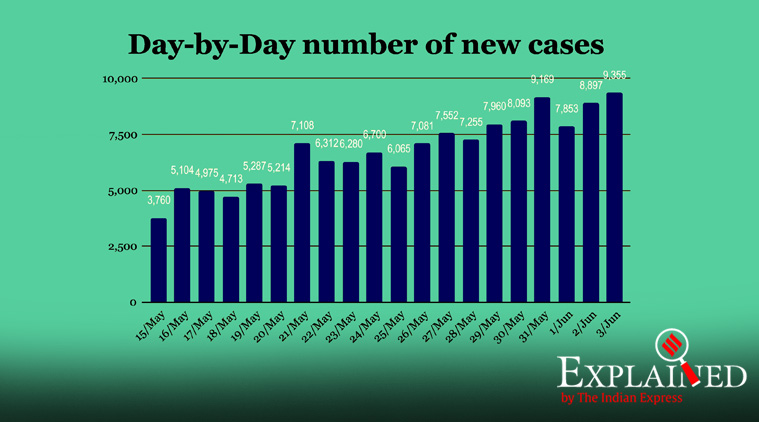- India
- International
India Coronavirus Numbers Explained: Why Delhi reports more cases than Mumbai
India Coronavirus (Covid-19) Cases Numbers: In the last four days relatively fewer people have come out in Mumbai to get themselves tested because of Cyclone Nisarga.
 Passengers wait to board trains at the New Delhi Railway Station on Wednesday. (Express Photo: Praveen Khanna)
Passengers wait to board trains at the New Delhi Railway Station on Wednesday. (Express Photo: Praveen Khanna)
India Coronavirus (Covid-19) Cases: On Wednesday, Delhi reported more cases of novel Coronavirus infections than Mumbai, the first time such a thing has happened in more than two months. Delhi discovered 1,513 new cases, it highest single-day figure, while Mumbai, which is the city with the maximum number of cases, found 1,276.
Delhi has been seeing a big surge in its numbers in the last one week, recording more than 1,000 new cases every day. Its case count has been growing at the fastest rate among the top five states with maximum caseload. The city now has 23,645 confirmed cases, out of which more than 9,500 have already recovered.
 More than 9,300 cases were reported from across the country on Wednesday.
More than 9,300 cases were reported from across the country on Wednesday.
Till about a week ago, Delhi was reporting between 500 and 800 cases every day, while Mumbai has been reporting over 1,200 cases for almost three weeks now. Mumbai has even reported 1,750 cases on a single day. In the last four days, however, relatively fewer people have come out in Mumbai to get themselves tested because of Cyclone Nisarga.
Also read | Coronavirus numbers explained: Why Mumbai is testing less than it can
In view of the rapidly rising cases in the national capital, Delhi has finally made it mandatory for everyone arriving in the city, whether by road, rail or air, to quarantine themselves at home for at least a week. Till now, Delhi-bound passengers were only expected to ‘self-monitor’ their health parameters, and report to authorities if they found any symptoms of Covid-19 disease.

Delhi has also decided to seal its borders with Haryana, just a day after they were opened. The borders were earlier sealed by Haryana which was concerned about the rising number of cases in Delhi was leading to a resurgence of infections in the neighbouring districts of Gurugram, Faridabad and Sonepat.
 Haryana is among the fastest growing states right now, with its case count having more than doubled in the last one week, from 1,381 on May 27 to 2,954 on Wednesday. The state had blocked all movement towards the national capital for more than a week, not just on the main highways, but even on the arterial and village roads connecting Delhi. On Wednesday, Haryana decided to resume inter-state bus services on some routes, but only on those that did not pass through Delhi.
Haryana is among the fastest growing states right now, with its case count having more than doubled in the last one week, from 1,381 on May 27 to 2,954 on Wednesday. The state had blocked all movement towards the national capital for more than a week, not just on the main highways, but even on the arterial and village roads connecting Delhi. On Wednesday, Haryana decided to resume inter-state bus services on some routes, but only on those that did not pass through Delhi.
More than 9,300 cases were reported from across the country on Wednesday. The total number of infections in India has now reached more than 2.17 lakh, of which almost 1.05 lakh people have recovered.
Top ten states with maximum caseload
| STATE | TOTAL POSITIVE | NEW CASES | TOTAL RECOVERIES | DEATHS
|
| Maharashtra | 74,860 | 2,560 | 32,329 | 2,587 |
| Tamil Nadu | 25,872 | 1,286 | 14,316 | 208 |
| Delhi | 23,645 | 1,513 | 9,542 | 606 |
| Gujarat | 18,117 | 485 | 12,212 | 1,122 |
| Rajasthan | 9,539 | 279 | 6,631 | 209 |
| Uttar Pradesh | 8,870 | 141 | 5,257 | 230 |
| Madhya Pradesh | 8,588 | 168 | 5,445 | 371 |
| West Bengal | 6,508 | 340 | 2,580 | 345 |
| Bihar | 4,326 | 230 | 2,025 | 25 |
| Karnataka | 4,063 | 267 | 1,514 | 55 |
After a couple of weeks of relative slowdown, the number of new infections in West Bengal have once again begun to rise fast. On Wednesday, the state reported 340 new cases to take its total to 6,508. In the last one week, the state has added more than 2,300 new cases, which is over one-third of its total caseload.
Bihar, another state with a fast growth rate, added 230 new cases on Wednesday, while Odisha, which has slowed down considerably in the last ten days, reported 90 new cases.
More Explained
EXPRESS OPINION
Apr 19: Latest News
- 01
- 02
- 03
- 04
- 05








































